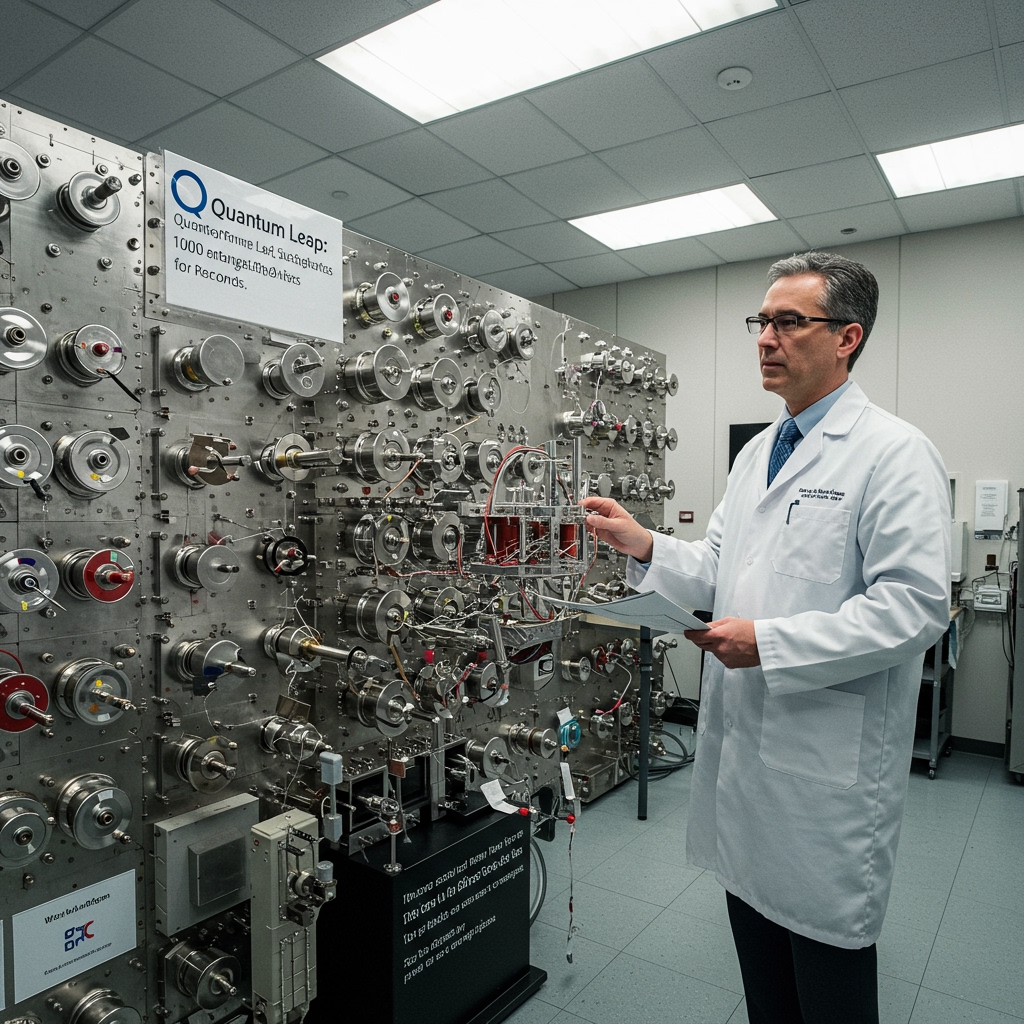On May 20, 2025, the independent research laboratory ‘QuantaPrime’ announced a groundbreaking achievement in the field of quantum computing. Scientists at the facility reported the successful sustainment of a quantum entangled state involving a record-breaking 1,000 qubits. This highly complex and delicate state was maintained for an unprecedented duration of 10 seconds. The announcement signals a significant step forward in the quest to build powerful, stable, and fault-tolerant quantum computers, machines with the potential to solve problems currently intractable for even the most powerful classical supercomputers. The details of this milestone were simultaneously released in a pre-print paper, providing the scientific community with immediate access to the methodology and results for review.
A New Benchmark in Quantum Entanglement
The achievement reported by ‘QuantaPrime’ sets a new benchmark in the challenging field of quantum computing. Entanglement, a phenomenon where two or more qubits become linked in such a way that they cannot be described independently of each other, regardless of the distance separating them, is a fundamental resource for quantum computation. The ability to create and control a large number of entangled qubits is crucial for building scalable and powerful quantum processors. While previous experiments have successfully entangled smaller numbers of qubits or maintained entanglement for shorter durations, sustaining a state involving 1,000 entangled qubits for a full 10 seconds represents a significant leap in both scale and coherence time. This prolonged coherence time is paramount; it dictates how long quantum computations can run before errors due to environmental decoherence become overwhelming. Achieving 10 seconds with such a large number of qubits suggests substantial progress in mitigating the fragility inherent in quantum systems.
Novel Techniques Powering the Breakthrough
The ‘QuantaPrime’ team attributed their success to the development and implementation of innovative technical solutions designed to protect the delicate quantum state from environmental noise. Central to their methodology are a novel cryogenic cooling system and an advanced photon trapping technique. The cryogenic system operates at temperatures extremely close to absolute zero, minimizing thermal vibrations that can disrupt qubit states. Unlike standard systems, this novel approach reportedly achieves unprecedented stability and temperature uniformity across a large array of qubits. Complementing the cooling is the photon trapping technique, which actively prevents stray photons from interacting with the qubits. Such unwanted interactions are a primary source of decoherence, causing the quantum state to collapse prematurely. By integrating these two sophisticated techniques, ‘QuantaPrime’ engineers and scientists created an environment where the entangled 1,000-qubit state could persist for a remarkably long period, allowing for potential computational operations that were previously infeasible within such a timeframe.
Fueled by Significant Investment
This significant scientific milestone was supported, in part, by substantial public investment in fundamental research. The ‘QuantaPrime’ laboratory received a $50 million grant from the National Science Foundation (NSF), a key U.S. government agency funding scientific research. This grant specifically targeted projects aimed at advancing quantum information science and technology. The successful outcome announced on May 20, 2025, underscores the impact of sustained, focused funding on accelerating progress in complex and potentially transformative fields like quantum computing. The NSF’s investment enabled ‘QuantaPrime’ to develop the specialized infrastructure, recruit top talent, and conduct the intricate experiments necessary to achieve this entanglement record.
Accelerating the Path to Fault Tolerance and Beyond
The ‘QuantaPrime’ breakthrough is expected to have profound implications for the future of quantum computing, most notably by potentially accelerating the timeline for the realization of fault-tolerant quantum computers. Current quantum computers are prone to errors due to decoherence and other noise sources. Fault tolerance relies on error correction codes that require a large number of physical qubits to encode a single logical qubit, the kind of stable qubit needed for reliable computation. Sustaining a large number of entangled qubits for a significant duration is a critical prerequisite for implementing these complex error correction schemes effectively. This achievement demonstrates the possibility of maintaining coherence at scale, bringing fault tolerance closer to reality.
Beyond fault tolerance, the ability to control and sustain large entangled states has direct implications for specific application areas. In cryptography, quantum computers pose a future threat to widely used encryption methods like RSA. Breakthroughs like ‘QuantaPrime’s’ accelerate the timeline for this ‘quantum threat,’ simultaneously highlighting the urgent need for developing and deploying quantum-resistant cryptographic algorithms. Conversely, quantum computers could also enable unbreakable quantum communication networks. In materials science, simulating the behavior of molecules and materials at the quantum level is a grand challenge for classical computers. A 1,000-qubit system with extended coherence time could potentially simulate far more complex molecular structures than currently possible, leading to the discovery of new catalysts, superconductors, or advanced materials with unprecedented properties. The implications extend across scientific disciplines and industrial sectors, from drug discovery to financial modeling and artificial intelligence.
Public Release and Future Outlook
The decision by ‘QuantaPrime’ to release a detailed pre-print paper concurrently with the announcement on May 20, 2025, emphasizes a commitment to transparency and open science, allowing the global research community to scrutinize the results and build upon the findings rapidly. This step is vital in validating the achievement and fostering collaborative progress in the fast-evolving quantum landscape. While significant challenges remain on the path to universal, fault-tolerant quantum computation, the sustained 1,000-qubit entanglement demonstrated by ‘QuantaPrime’ marks a crucial experimental validation of scaling up quantum systems while maintaining coherence. It serves as compelling evidence that the technological hurdles, though formidable, are surmountable with innovative engineering and dedicated research. The scientific community will undoubtedly study the ‘QuantaPrime’ pre-print closely, integrating these new techniques and insights into their own efforts to push the boundaries of what is possible with quantum technology. This breakthrough represents a pivotal moment, bringing the transformative potential of quantum computing closer to practical realization.





